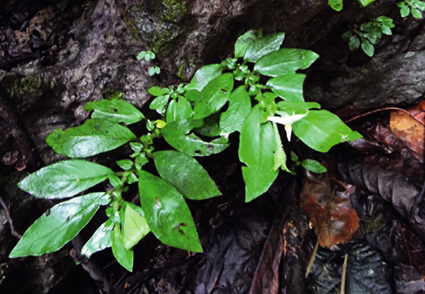Abstract
We describe Argostemma mirae (Rubiaceae) a new species from Mt. Tingtingan, Badong, Tago, Surigao del Sur, Mindanao Island, Philippines. It grows on a shady mossy limestone forest on a lower elevation. A. mirae resembles A. solaniflorum in having branching and pubescent stems, oblanceolate leaves, pubescent petioles, terminal to axillary inflorescence, and white corollas but differs in having shorter stems, smaller leaf blades, 4 calyx lobes and 4 corollas. Based on IUCN criteria we proposed data deficient (DD) since there is only one population currently known.
References
- Alejandro, G.J.D. (2007) The current status of the Philippine Rubiaceae. Philippine Journal of Systematic Biology 1: 47–60. https://doi.org/10.3860/pjsb.v1i1.908
- Balan, A.P.., Robi, A.J. & Sasidharan, N. (2021) Argostemma quarantena (Rubiaceae, Rubioidae), a new species from Southern Western Ghats, India. Webbia Journal of Plant Taxonomy and Geography 76 (1): 47–52. https://doi.org/10.36253/jopt-9592
- Blasco, F.A., De Guzman, G.Q. & Alejandro, G.J.D. (2014) A Survey of Ethnomedicinal Plants in Surigao del Sur Mountain Range, Philippines. International Journal of Pure and Applied Bioscience 2: 166–72.
- Bremer B (1987) The sister group of the paleotropical tribe Agrostemmateae: a redefined neotropical tribe Hamelieae (Rubiaceae, Rubioideae). Cladistics 3: 35–51. https://doi.org/10.1111/j.1096-0031.1987.tb00495.x
- Bremer, B. & Manen, J.F. (2000) Phylogeny and classification of the subfamily Rubioideae (Rubiaceae). Plant Systematics and Evolution 225: 43–72. https://doi.org/10.1007/BF00985458
- Chen, T. & Taylor, C.M. (2011) Argostemma. In: Wu, Z.Y., Raven, P.H. & Hong, D.Y. (Eds.) Flora of China, vol. 19. Science Press, Beijing & Missouri Botanical Garden Press, St. Louis, pp. 75–77. [http://www.iplant.cn/foc/pdf/Argostemma.pdf]
- Elmer, A.D.E. (1906) Philippine Rubiaceae. Leaflets on Philippine Botany 1 (1): 2.
- Elmer, A.D.E. (1934) Philippine Rubiaceae , Leaflets on Philippine Botany 1 (9): 3243.
- Hsu, H.W.C. Aranas, D.R., Alejandro, G.J.D. & Schumann, S.L. (2020) A new species of Argostemma (Rubiaceae) with free stamens in star-shaped corolla from the Philippines. Phytotaxa 437 (2) : 113–117. https://doi.org/10.11646/phytotaxa.437.2.7
- Ilagan, V.A.D., Alejandro, G.J.D., Paraguison, D.J.B., Perolina, S.M.W., Raterta, R. & Blasco, F.A. (2022) Ethnopharmacological Documentation and Molecular Authentication of Medicinal Plants used by the Manobo and Mamanwa tribes of Surigao del Sur, Philippines. Biodiversitas Journal of Biological Diversity 23 (6): 3185–3202. https://doi.org/10.13057/biodiv/d230646
- IUCN Standards & Petitions Committee. (2022) Guidelines for Using the IUCN Red List Categories and Criteria. Version 15.1. Available from: https://www.iucnredlist.org/documents/RedListGuidelines.pdf (accessed: 6 March 2024).
- Liu, Z-C., Liu, J., Zhao W-Y., Fan, Q., Ye, H-G., Wang, L. & Liao, W.-B. (2022) Argostemma ehuangzhangense (Rubiaceae), a new species from Guangdong, China. PhytoKeys 214: 75–82. https://doi.org/10.3897/phytokeys.214.89276
- Mazo, K.R.F. & Famor, C.V. (2022) Rediscovery and Amended Description of a Philippine endemic Argostemma arachnosum (Rubiaceae). Nordic Journal of Botany 2022: e03688. https://doi.org/10.1111/njb.03688
- Merrill, E.D. (1922) Noteworthy Philippine Plants XVII. Philippine Journal of Science 20: 465–465.
- Pelser, P.B., Barcelona, J.F. & Nickrent, D.L. (Eds.) (2011–present) Co’s Digital Flora of The Philippines. Available from: www.philippineplants.org (accessed: 6 March 2024).
- Puff, C., Igersheim, A., Buchner, R. & Rohrhofer, U. (1995) The united stamens of Rubiaceae. Morphology, Anatomy; their role in pollination ecology. Annals of the Missouri Botanical Garden 82: 357–382. https://doi.org/10.2307/2399888
- Schumann, K.M. & Lauterbach, C.A.G. (1905) Nachtrage zur Flora der deutschen Schutzgebiete in der Sudsee. 393 pp.
- Sridith, K. & Puff, C. (2000) Distribution of Argostemma Wall. (Rubiaceae) with special reference to Thailand and surrounding areas. Thai Forest Bulletin, Botany 28: 123–137. [https://li01.tci-thaijo.org/index.php/ThaiForestBulletin/article/view/24959/21238]
- Valeton, T. (1911) Nova Guinea; A Journal of Botany, Zoology, Anthropology, Ethnography, Geology and Paleontology of The Papuan Region. Leiden 8: 447–448.
- Wallich N (1824) Argostemma. In: Carey, W. & Wallich, N. (Eds.) Flora Indica: or Descriptions of Indian plants. Vol. 2. The Mission Press, Serampore, 324–325.
- Walpers, W.G. (1843) Novorum Actorum Academiae Caesareae Leopoldinae-Carolinae Naturae Curiosorum 19 (suppl. 1): 329.


